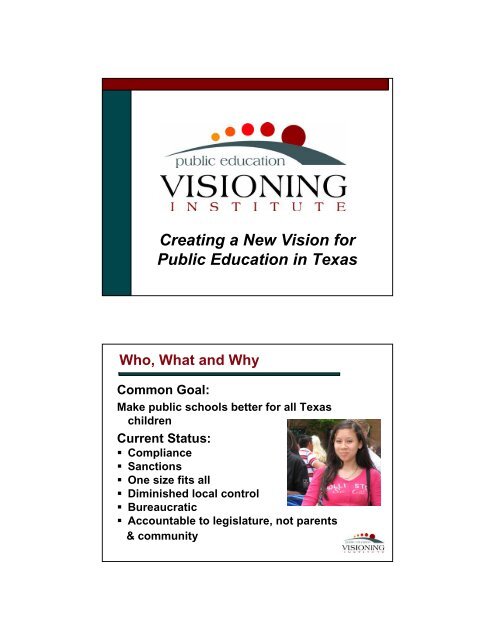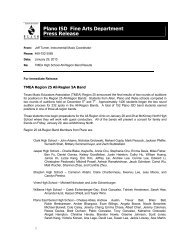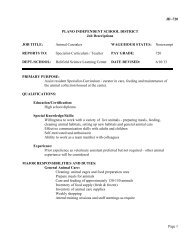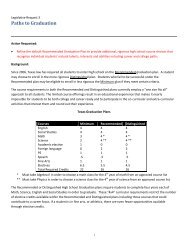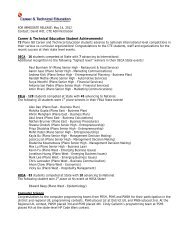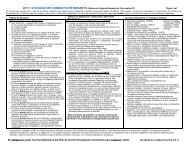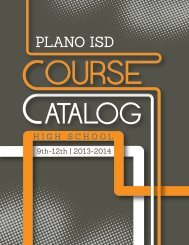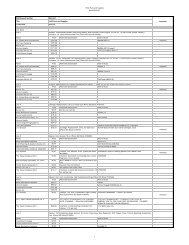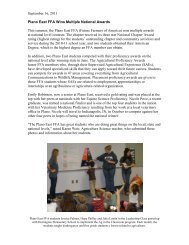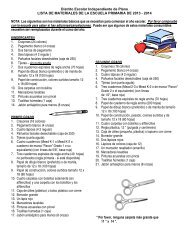Creating a New Vision for Public Education in Texas
Creating a New Vision for Public Education in Texas
Creating a New Vision for Public Education in Texas
You also want an ePaper? Increase the reach of your titles
YUMPU automatically turns print PDFs into web optimized ePapers that Google loves.
<strong>Creat<strong>in</strong>g</strong> a <strong>New</strong> <strong>Vision</strong> <strong>for</strong><br />
<strong>Public</strong> <strong>Education</strong> <strong>in</strong> <strong>Texas</strong><br />
Who, What and Why<br />
Common Goal:<br />
Make public schools better <strong>for</strong> all <strong>Texas</strong><br />
children<br />
Current Status:<br />
• Compliance<br />
• Sanctions<br />
• One size fits all<br />
• Dim<strong>in</strong>ished local control<br />
• Bureaucratic<br />
• Accountable to legislature, not parents<br />
& community
Values/Direction<br />
• Where are we<br />
headed?<br />
• Do we like the<br />
direction we are<br />
tak<strong>in</strong>g?<br />
• What beliefs are<br />
compell<strong>in</strong>g us?<br />
• How would we<br />
describe the future<br />
we seek (vision)?<br />
Resources, Speakers, and<br />
Facilitators<br />
• Phil Schlechty<br />
• Lauren Resnick/Judy Johnson<br />
• Doug Reeves<br />
• Ian Jukes/Ted McCa<strong>in</strong><br />
• Michael Fullan<br />
• Marc Prensky<br />
• Milton Chen<br />
• John Horn
Major Conceptual Themes<br />
• A <strong>New</strong> Direction Now<br />
• Engag<strong>in</strong>g the Digital Generation<br />
• <strong>New</strong> Learn<strong>in</strong>g Standards <strong>for</strong> a <strong>New</strong> Era<br />
• Unleash<strong>in</strong>g the Power of Assessment “For”<br />
Learn<strong>in</strong>g<br />
• Mov<strong>in</strong>g from Accountabalism to Accountability<br />
that Inspires<br />
• Trans<strong>for</strong>m<strong>in</strong>g Schools <strong>in</strong>to Learn<strong>in</strong>g<br />
Organizations<br />
• Communities Tak<strong>in</strong>g Back their Schools<br />
<strong>New</strong> System,<br />
<strong>New</strong> Culture,<br />
<strong>New</strong> Structures
Six Statements of Pr<strong>in</strong>ciple<br />
1. The <strong>New</strong> Digital Learn<strong>in</strong>g Environment<br />
2. The <strong>New</strong> Learn<strong>in</strong>g Standards<br />
3. Assessments <strong>for</strong> Learn<strong>in</strong>g<br />
4. Accountability <strong>for</strong> Learn<strong>in</strong>g<br />
5. Organizational Trans<strong>for</strong>mation<br />
6. A More Balanced<br />
and Re-Invigorated<br />
State/Local Partnership<br />
Article I: The <strong>New</strong> Digital Learn<strong>in</strong>g<br />
Environment
Prensky reports that:<br />
• Students have to “power-down” when they<br />
come to school!<br />
Article I – The <strong>New</strong> Digital<br />
Learn<strong>in</strong>g Environment<br />
• Digitization-m<strong>in</strong>iaturizationglobalization<br />
• <strong>New</strong> digital tools<br />
• Social network<strong>in</strong>g<br />
• “Any place, any pace, any time”<br />
now possible<br />
• Access to <strong>in</strong><strong>for</strong>mation<br />
now open to all<br />
• Creation of knowledge by<br />
students
Article II: The <strong>New</strong> Learn<strong>in</strong>g<br />
Standards<br />
Profound<br />
Learn<strong>in</strong>g<br />
Student<br />
Engagement<br />
Learn<strong>in</strong>g <strong>for</strong> the<br />
21 st Century<br />
Multiple<br />
Intelligences<br />
Article III: Assessments <strong>for</strong><br />
Learn<strong>in</strong>g
Article III – Assessments <strong>for</strong><br />
Learn<strong>in</strong>g<br />
• Three levels:<br />
• Classroom - impact<br />
on student ef<strong>for</strong>t<br />
• Program - effectiveness<br />
• Institutional - accountability<br />
• Less reliance on<br />
standardized tests<br />
• More use of per<strong>for</strong>mances,<br />
portfolios, exams, and<br />
demonstrations<br />
• Sampl<strong>in</strong>g techniques -<br />
external reviewers <strong>for</strong><br />
graduates<br />
Article IV: Accountability <strong>for</strong><br />
Learn<strong>in</strong>g<br />
• Comprehensive accountability<br />
systems are essential <strong>for</strong><br />
achiev<strong>in</strong>g improved<br />
per<strong>for</strong>mance.<br />
• Accountability provisions<br />
should be based on multiple<br />
measures.<br />
• Accountability systems should<br />
not be based on the “lowest<br />
common denom<strong>in</strong>ator” <strong>for</strong> a<br />
campus or district.
Article V: Organizational<br />
Trans<strong>for</strong>mation<br />
Article V – Organizational<br />
Trans<strong>for</strong>mation<br />
• Mov<strong>in</strong>g from bureaucracies<br />
to learn<strong>in</strong>g organizations<br />
• Schools are places where<br />
students want to be<br />
and adults want to work<br />
• Culture and structure<br />
that support a focus on<br />
student engagement<br />
• Less reliance on power and authority
Article VI: A More Balanced and Re-<br />
Invigorated State/Local Partnership<br />
Article VI – A More Balanced &<br />
Re<strong>in</strong>vigorated State/Local<br />
Partnership<br />
• <strong>Public</strong> <strong>Education</strong> is:<br />
• a local function,<br />
• a state responsibility, and<br />
• a federal concern<br />
(Schools cannot be run from Aust<strong>in</strong><br />
and Wash<strong>in</strong>gton without<br />
standardization and the debilitat<strong>in</strong>g<br />
bureaucracies remote control requires.)<br />
• Schools & boards must build their<br />
communities - ownership &<br />
connectivity<br />
• Community alliances - essential <strong>for</strong><br />
serv<strong>in</strong>g all
Legislative Initiatives Required<br />
• Revise current curriculum specifications<br />
to frameworks <strong>for</strong> new learn<strong>in</strong>g standards.<br />
• Trans<strong>for</strong>m the assessment system to one<br />
of multiple types of assessments with a<br />
primary focus on <strong>in</strong><strong>for</strong>m<strong>in</strong>g <strong>in</strong>struction.<br />
• Trans<strong>for</strong>m the <strong>Texas</strong> <strong>Education</strong> Code from<br />
overly prescriptive regulations and<br />
practices imposed on schools to a<br />
streaml<strong>in</strong>ed compendium of major policies<br />
that support new learn<strong>in</strong>g standards.<br />
Legislative Initiatives Required cont.<br />
• Trans<strong>for</strong>m the accountability system from<br />
one based primarily on standardized test<br />
scores with counterproductive high-stakes<br />
to a system based on <strong>in</strong>spirational<br />
standards.<br />
• Trans<strong>for</strong>m the <strong>Texas</strong> <strong>Education</strong> Agency as a<br />
compliance organization to one that<br />
provides leadership and technical<br />
assistance to school districts.
Kudos to School Leaders!!<br />
Gallup Poll 2008:<br />
In your op<strong>in</strong>ion, who should the next president rely on<br />
most <strong>for</strong> advice about education policy?<br />
education leaders, political leaders, or<br />
bus<strong>in</strong>ess leaders<br />
Responses:<br />
• <strong>Education</strong> leaders………………77%<br />
• Political leaders………………… 4%<br />
• Bus<strong>in</strong>ess leaders……………….14%<br />
• Don’t know……………………... 5%<br />
--- 40th Annual PDK/Gallup Poll, September 2008<br />
Goal of <strong>Vision</strong><strong>in</strong>g Institute<br />
• To create conversations<br />
about issues raised <strong>in</strong><br />
the document that will<br />
lead to strategic actions<br />
at the local and state<br />
level to br<strong>in</strong>g about an<br />
improved education<br />
system <strong>for</strong> <strong>Texas</strong><br />
students.
<strong>Creat<strong>in</strong>g</strong> a <strong>New</strong> <strong>Vision</strong> <strong>for</strong><br />
<strong>Public</strong> <strong>Education</strong> <strong>in</strong> <strong>Texas</strong><br />
http://www.tasanet.org/files/vision<strong>in</strong>g/vision<strong>in</strong>gf<strong>in</strong>al.pdf<br />
District Tax Rate<br />
Tax Rate History<br />
$1.80<br />
$1.60<br />
$1.40<br />
$1.20<br />
$1.00<br />
$0.80<br />
$0.60<br />
$0.40<br />
$0.20<br />
$-<br />
$1.50<br />
$1.33<br />
$1.02 $1.04<br />
2005-06 2006-07 2007-08 2008-09<br />
Tax Rate
District Total Revenues Per WADA<br />
TOTAL REVENUES PER WADA<br />
6,800<br />
6,400<br />
6,000<br />
5,600<br />
5,200<br />
4,800<br />
4,400<br />
4,000<br />
320<br />
323 294 292<br />
271<br />
107<br />
220 224 229<br />
5,416 5,416 5,416 5,416 5,416<br />
OTHER STATE<br />
REVENUE<br />
TAX REVENUE<br />
RETAINED<br />
STATE TARGET<br />
REVENUES PER<br />
WADA<br />
3,600<br />
Actual<br />
2006-07<br />
Estimated<br />
2007-08<br />
Budget<br />
2008-09<br />
Projected<br />
2009-10<br />
Projected<br />
2010-11


